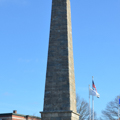You are here
Groton Monument
Built adjacent to Fort Griswold and towering 135 feet tall, the Groton Monument stands as a monumental testament to the effort to memorialize important sites of the Revolutionary War in the early nineteenth century. This structure, which was designed by the firm of Town and Davis and commemorates the battle of Groton Heights, takes the form of a tapered obelisk set on a cubic plinth measuring 22 feet square with a spiral staircase inside. An iron observation cupola originally topped the structure, but this was removed in 1881 when the obelisk shaft was extended and the current pyramidion was added.
On September 6, 1781, British troops led by Benedict Arnold attacked Fort Griswold, a small trapezoidal fort with three bastions built between 1775 and 1778 on a strategic promontory overlooking the Thames River in Groton. According to accounts of the battle, after surrendering, British troops overtook the fort and subsequently massacred all the surviving American soldiers, making it one of the last tragedies of the war. Beginning in the 1820s, there was a groundswell of interest in creating permanent memorials to the Revolutionary War as memory of its battles was beginning to fade. The first of these was the Bunker Hill Monument, begun in June 1825. Soon afterward, a group of individuals in southeastern Connecticut banded together to form the Groton Monument Association with the purpose of building a memorial to commemorate the massacre at Fort Griswold. After securing funding through a state-sponsored lottery, ground was broken on September 6, 1826 and by 1830 work on the monument was finished. As the Groton Monument Association stated in a petition to the Connecticut legislature, the memorial was to be a simple solid structure that would endure for eternity, like the still-standing monuments of antiquity. Following the precedent of Boston, it was decided that the memorial should be a giant obelisk measuring over a hundred feet in height. But unlike those from ancient Egypt, the Groton Monument was to be built of many pieces of stone (large rusticated blocks of locally quarried granite) and feature an internal staircase like the honorific columns of Rome and their later copies. As such, it helped to establish a distinctly new type of architectural memorial. The Monument Association also consciously spurned the use of sculpture, which they believed would “attract more admiration for the artist than the event intended to be commemorated.” The simplicity of the monument also increased its legibility from great distances, particularly from ships entering New London harbor.
The entrance to the monument is adorned with a classicized bronze door and a large marble plaque, which memorializes the “brave patriots” who died nearby in 1781. It also vilifies the actions of the British soldiers “under the command of the traitor Benedict Arnold.” Thus, as the inscription makes clear, this massive stone obelisk served to perpetuate the memory of those who died in the massacre at Fort Griswold as well as the perfidious actions of Connecticut’s most infamous native son. Its classically inspired form also generally reinforced the link contemporary writers made between the soldiers who died on that site and the illustrious warriors of antiquity. For the centennial of the Battle of Groton Heights, the iron cage atop the monument was replaced with a pyramidion to more closely resemble an Egyptian obelisk. It also brought the form of the structure closer to that of the Bunker Hill Monument, which was only completed in 1843. This addition, built with gray granite blocks, is still easily discernable today.
Adjacent to the obelisk is the Monument House, the front section of which was originally the caretaker’s residence. The Daughters of the American Revolution converted this small structure into a museum in 1898, and later expanded it in 1906. This addition, which features decorative boulder masonry in the style of H. H. Richardson and his successors, also served to commemorate the Spanish-American War. The surrounding memorial landscape was further embellished in 1911 when the state transformed the remains of Fort Griswold into a public park and constructed a monumental stone gateway flanked by cannons.
References
Bartlett, T.H. “Early Settler Memorials V: Groton Heights Celebration and Monument.” The American Architect and Building News 21, no. 575 (January 1, 1887): 3–5.
Giguere, Joy M. Characteristically American: Memorial Architecture, National Identity, and the Egyptian Revival. Knoxville: University of Tennessee Press, 2014.
Zukowsky, John. “Monumental American Obelisks: Centennial Vistas.” The Art Bulletin 58, no. 4 (December 1976): 574–581.
Writing Credits
If SAH Archipedia has been useful to you, please consider supporting it.
SAH Archipedia tells the story of the United States through its buildings, landscapes, and cities. This freely available resource empowers the public with authoritative knowledge that deepens their understanding and appreciation of the built environment. But the Society of Architectural Historians, which created SAH Archipedia with University of Virginia Press, needs your support to maintain the high-caliber research, writing, photography, cartography, editing, design, and programming that make SAH Archipedia a trusted online resource available to all who value the history of place, heritage tourism, and learning.
















